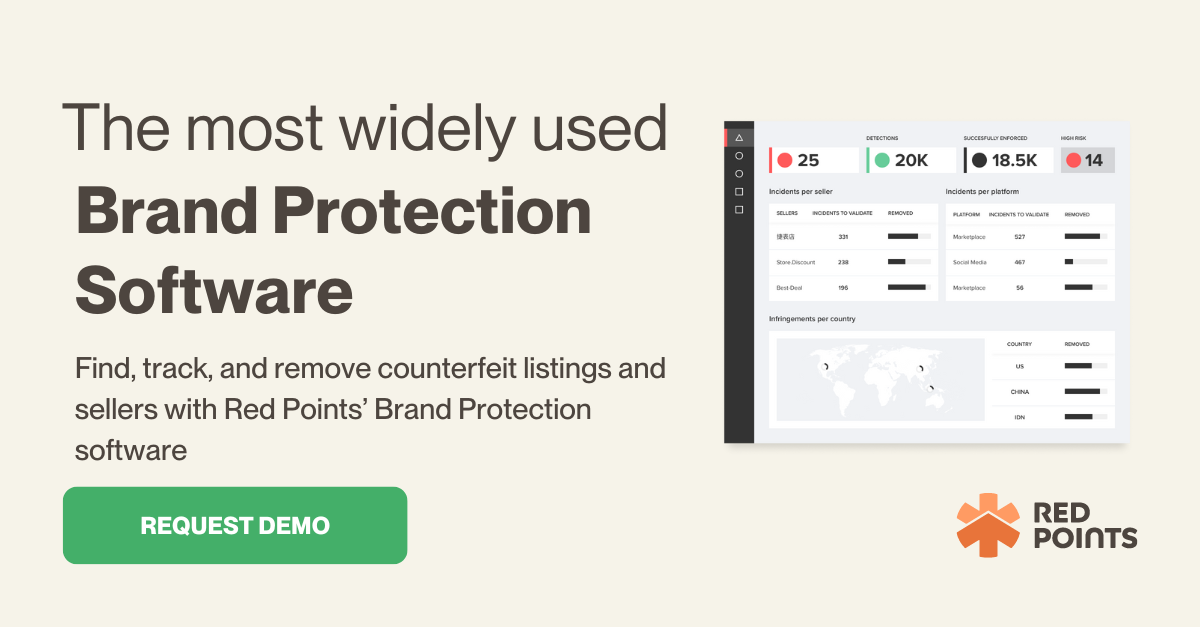Cybercrime can cost SMBs more than $2.2 million a year.
As a result, it isn’t surprising to learn that more than 60 percent of businesses that fall victim to cybercrime go out of business within six months.
Due to the pandemic, establishing a presence online has become a necessity for businesses with so many shoppers going online as well. But this has also given rise to cybercrimes and scams.
In today’s increasingly digital world, protecting your business from cybercrime has become just as important as moving your business operations online.
In this article, we discuss:
- What is cybercrime prevention?
- 5 ways to protect your company from cybercrime
- How Red Points can help proactively protect your business
What is cybercrime prevention?
Cybercrime prevention involves taking proactive steps to prevent your business from cybercrime attacks.
It can be next to impossible to build the perfect defense when your business has already been attacked by cybercriminals. Taking preventive steps in advance, setting the right priorities for your business, and appropriately analyzing your current security infrastructure can not only help you tackle any future attacks but it can also help you avoid cyber attacks altogether.
5 ways to protect your company from cybercrime
1- Understand the new cybercrime trends and evolving risks
Cybercriminals are getting smarter by the day as they are constantly on the lookout for newer ways to attack unsuspecting businesses. To be one step ahead of them and to protect your business, you need to be prepared by having a clear understanding of all the ways that cybercrime can impact your business.
Here are some of the common cyberattacks that you should be aware of:
- Phishing: A very common type of cyberthreat, especially in ecommerce is phishing which occurs when cybercriminals create almost authentic-looking fraudulent websites to collect personal information like credit card details and passwords from unsuspecting people.
- Hacking: The goal of hacking is also to get access to personal information of your customers like login passwords, phone numbers, and email addresses. But with hacking, cybercriminals gain unauthorized access to a business’s internal systems and database in order to extract sensitive information
- Malware attacks: Malware is essentially malicious software that is developed by cybercriminals and unknowingly installed on devices or online platforms to get access to sensitive information. While it cannot damage your hardware in any way, it can stay on your system very quietly while collecting sensitive business data.
- Identity theft: This happens when cybercriminals create a fraud website or social media impersonating businesses to trick customers into obtaining their personal information
- Intellectual property theft: This can vary from the sale of counterfeit products, patent infringement, content pirac and more.
2- Conduct regular employee training
Over 95 percent of cybersecurity breaches happen because of human error. That means you could install the most advanced cybersecurity platforms for your business but if your employees are not actively trained in following proper security practices, it can end up creating huge vulnerabilities.
That is why, it is absolutely essential to train employees so that they can actively recognize the warning signs of any cybercrimes. At the same time, you should also put a system in place for reporting any signs of attacks that employees may see.
You can introduce two-factor authentication for employee logins, implement thorough verification every time a new device is used to sign up, and urge employees to change their passwords every two weeks.
More importantly, educating your employees about cybercrime shouldn’t just be a one-off thing. Cyber security training should be conducted on a regular basis to keep up with all the new cybercrime trends and ensure employees are always aware of the new security vulnerabilities.
3- Develop a robust security policy
With more and more sensitive data being stored online, there is a need for an expansive security policy that not only covers standard security practices like data backup and audits, but also covers considerably new security concerns like social media theft and cloud security.
A security policy includes all the security practices that should be followed in order to keep your business data secure. The policy will essentially cover all the important aspects of your business including hardware, software, employee training, and incident response plans.
The goal behind creating this exhaustive policy document is to ensure you never miss out on anything and things don’t fall through the cracks even when your employees are busy managing their core work responsibilities.
It also helps set out the right policies to mitigate any security risks before they cause any severe damage to your business.
4- Keep your hardware and software updated
When businesses are too busy managing their daily operations to ensure their hardware and software are always updated, it can cause serious vulnerabilities and security flaws.
Cybercriminals are always looking for newer ways to attack businesses and the only way to stay one step ahead of them is by constantly updating your systems and keeping your guards up.
In fact, over 60 percent of organization security attacks target hardware and software systems that are over 10 years old.
As a result, it is necessary to be proactive and ensure your security systems are always up to date to protect your business against new threats.
5- Consider a software that protects you from cybercrime
Managing cybersecurity for your organization can seem rather overwhelming when you are already busy managing your core responsibilities. Instead you can consider adopting a software that can automatically prevent malware attacks, protect business data against unauthorized access, and improve business continuity management – all of which combined can significantly reduce security risks.
How does brand protection software protect brands from cybercrime?
While a cybersecurity software can help you avoid malwares attacks or hackers trying to target your business, it cannot successfully fight against phishing and identity theft. That’s because cybersecurity software is built to protect your internal systems, not actively look on the outside at other websites copying your brand aesthetics or product designs.
Instead, you can consider getting Brand Protection software and Anti Piracy software that work as an extension of your team and help you protect your business against cybercriminals. While the Brand Protection software can actively find, track, and remove counterfeit listings, the Anti Piracy can track pirated content online and actively take down illegal content.
Take a look at how to choose the right brand protection solution for your business to decide the best approach for managing cybersecurity.
What’s next
We are moving into the post-pandemic world where businesses have no choice but to create a strong online presence while ensuring that they are always protected against cybercrime.
Red Points can help streamline the process with its Brand Protection Software
Check out Red Points Brand Protection Software can protect your business against cybercrime.



